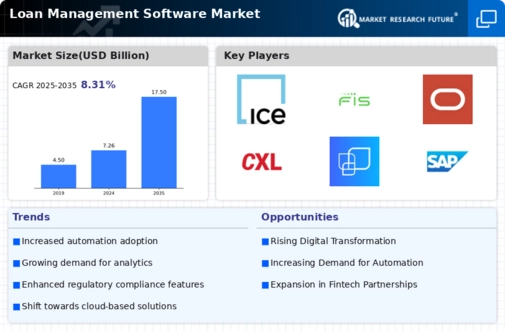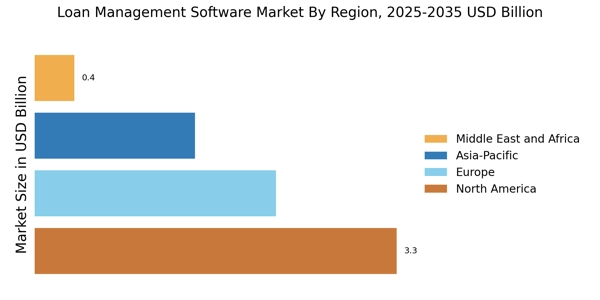Emergence of Fintech Innovations
The Loan Management Software Market is being reshaped by the emergence of fintech innovations that are revolutionizing traditional lending practices. Fintech companies are leveraging technology to offer streamlined loan processes, faster approvals, and enhanced customer interactions. This disruption is prompting established financial institutions to adopt similar technologies to remain competitive. The market is expected to witness a compound annual growth rate of around 15% as traditional lenders increasingly integrate fintech solutions into their operations. This trend suggests that the Loan Management Software Market will continue to evolve, driven by the need for agility and innovation in response to changing consumer preferences.
Increased Focus on Customer Experience
The Loan Management Software Market is witnessing a pronounced shift towards enhancing customer experience. As competition intensifies, financial institutions are prioritizing customer satisfaction and engagement. Loan management software that offers user-friendly interfaces, personalized services, and efficient communication channels is becoming essential. Recent studies indicate that organizations that invest in customer-centric loan management solutions experience a 30% increase in customer retention rates. This focus on customer experience not only fosters loyalty but also attracts new clients, thereby propelling growth in the Loan Management Software Market. As customer expectations continue to evolve, the demand for innovative solutions that enhance the borrowing experience is expected to rise.
Rising Demand for Digital Transformation
The Loan Management Software Market is experiencing a notable surge in demand driven by the broader trend of digital transformation across various sectors. Organizations are increasingly seeking to enhance operational efficiency and customer experience through the adoption of advanced technologies. This shift is evidenced by a projected growth rate of approximately 12% annually in the loan management software segment, as businesses recognize the necessity of modernizing their processes. The integration of digital solutions not only streamlines loan processing but also improves data management and analytics capabilities. As financial institutions strive to remain competitive, the emphasis on digital transformation is likely to continue shaping the Loan Management Software Market, fostering innovation and responsiveness to customer needs.
Growing Need for Enhanced Risk Management
In the Loan Management Software Market, the growing need for enhanced risk management is becoming increasingly apparent. Financial institutions are under pressure to mitigate risks associated with lending, including credit risk, operational risk, and compliance risk. The implementation of sophisticated loan management software solutions enables organizations to better assess borrower creditworthiness and monitor loan performance. According to recent data, institutions utilizing advanced risk management tools have reported a 20% reduction in default rates. This trend suggests that as the financial landscape evolves, the demand for robust risk management features within loan management software will likely intensify, driving further growth in the market.
Regulatory Compliance and Reporting Requirements
The Loan Management Software Market is significantly influenced by the increasing regulatory compliance and reporting requirements imposed on financial institutions. As governments and regulatory bodies implement stricter guidelines, organizations must ensure that their loan management processes adhere to these standards. Software solutions that facilitate compliance reporting and automate regulatory updates are in high demand. The market is projected to grow by approximately 10% annually as institutions seek to avoid penalties and enhance their compliance frameworks. This trend indicates that the Loan Management Software Market will continue to expand as compliance becomes a critical focus for lenders, driving the need for sophisticated software solutions.


















Leave a Comment